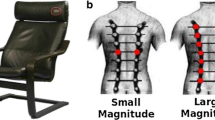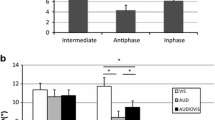Abstract
Previous work on sensorimotor synchronization has investigated the dynamics of finger tapping and how individual movement trajectories contribute to timing accuracy via asymmetry in movement velocities. The present study investigated sensorimotor synchronization (in-phase) and syncopation (anti-phase) to both an auditory metronome and a visual flashing light at multiple frequencies to understand how individual movement phases contribute to the variability of timekeeping and error correction in different sensory modalities and with different task constraints. Results demonstrate that the proportional time spent in both the upward phase of movement and the holding phase of movement (time spent on the surface of the table) remain relatively invariant across both stimulus modalities and across tapping styles (syncopation and synchronization), but changes with interval duration, increasing as interval duration increases. The time spent in the downward phase of movement did significantly differ across stimulus modality and tapping style, increasing during both visuomotor timing and syncopation, accompanied by a significant decrease in flexion velocity during syncopation. Extension velocity and flexion time were found to be the main contributors to differences between visual and auditory timing, while flexion velocity and flexion time were found to be the main contributors to differences between synchronization and syncopation. No correlations were found between asynchrony and the upward, downward, or holding phases of movement, suggesting the existence of multiple error correction strategies.





Similar content being viewed by others
References
Balasubramaniam R (2005) Trajectory formation in timed repetitive movements. In: Latash ML, Lestienne F (eds) Progress in motor control IV. Springer, New York, pp 47–54
Balasubramaniam R, Wing AM, Daffertshofer A (2004) Keeping with the beat: movement trajectories contribute to movement timing. Exp Brain Res 159:129–134
Bates D, Maechler M, Bolker B, Walker S (2015) Fitting linear mixed-effects models using lme4. J Stat Soft 67(1):1–48
Comstock DC, Balasubramaniam R (2018) Neural responses to perturbations in visual and auditory metronomes during sensorimotor synchronization. Neuropsychologia 117:55–66
Comstock DC, Hove MJ, Balasubramaniam R (2018) Sensorimotor synchronization with auditory and visual modalities: behavioral and neural differences. Front Comput Neurosci 12:53. https://doi.org/10.3389/fncom.2018.00053
Delignières D, Torre K, Lemoine L (2009) Long-range correlation in synchronization and syncopation tapping: a linear phase correction model. PloS One 4(11):e7822
Doumas M, Wing AM (2007) Timing and trajectory in rhythm production. J Exp Psychol Hum Percept Perform 33:442
Gibbon J (1977) Scalar expectancy theory and Weber’s law in animal timing. Psychol Rev 84:279
Hove MJ, Keller PE (2010) Spatiotemporal relations and movement trajectories in visuomotor synchronization. Music Percept Interdiscip J 28(1):15–26
Hove MJ, Spivey MJ, Krumhansl CL (2010) Compatibility of motion facilitates visuomotor synchronization. J Exp Psychol Hum Percept Perform 36(6):1525
Hove MJ, Fairhurst MT, Kotz SA, Keller PE (2013) Synchronizing with auditory and visual rhythms: an fMRI assessment of modality differences and modality appropriateness. Neuroimage 67:313–321
Hove MJ, Balasubramaniam R, Keller PE (2014) The time course of phase correction: a kinematic investigation of motor adjustment to timing perturbations during sensorimotor synchronization. J Exp Psychol Hum Percept Perform 40:2243
Huang YZ, Edwards MJ, Rounis E, Bhatia KP, Rothwell JC (2005) Theta burst stimulation of the human motor cortex. Neuron 45(2):201–206
Jäncke L, Loose R, Lutz K, Specht K, Shah NJ (2000) Cortical activations during paced finger-tapping applying visual and auditory pacing stimuli. Cogn Brain Res 10(1):51–66
Krause V, Schnitzler A, Pollok B (2010) Functional network interactions during sensorimotor synchronization in musicians and non-musicians. Neuroimage 52(1):245–251
Kurgansky AV (2008) Visuomotor synchronization: analysis of the initiation and stable synchronization phases. Hum Physiol 34(3):289–298
Kuznetsova A, Brockhoff PB, Christensen RHB (2017) lmerTest package: tests in linear mixed effects models. J Stat Soft 82(13):1–26
Lorås H, Sigmundsson H, Talcott JB, Öhberg F, Stensdotter AK (2012) Timing continuous or discontinuous movements across effectors specified by different pacing modalities and intervals. Exp Brain Res 220(3–4):335–347
Mayville JM, Fuchs A, Ding M, Cheyne D, Deecke L, Kelso JA (2001) Event-related changes in neuromagnetic activity associated with syncopation and synchronization timing tasks. Hum Br Map 14:65–80
Nagasaki H (1989) Asymmetric velocity and acceleration profiles of human arm movements. Exp Brain Res 74:319–326
Nagasaki H (1991) Asymmetrical trajectory formation in cyclic forearm movements in man. Exp Brain Res 87:653–661
Patel AD (2014) The evolutionary biology of musical rhythm: was Darwin wrong? PLoS Biol 12(3):e1001821
Patel AD, Iversen JR (2014) The evolutionary neuroscience of musical beat perception: the action simulation for auditory prediction (ASAP) hypothesis. Front Syst Neurosci 8:57
Penhune VB, Zatorre RJ, Evans AC (1998) Cerebellar contributions to motor timing: a PET study of auditory and visual rhythm reproduction. J Cogn Neurosci 10(6):752–765
R Core Team (2015) R: a language and environment for statistical computing. R Foundation for Statistical Computing, Vienna
Repp BH (2003) Rate limits in sensorimotor synchronization with auditory and visual sequences: the synchronization threshold and the benefits and costs of interval subdivision. J Motor Behav 35(4):355–370
Repp BH (2005) Sensorimotor synchronization: a review of the tapping literature. Psychon Bull Rev 12:969–992
Repp BH, Penel A (2002) Auditory dominance in temporal processing: new evidence from synchronization with simultaneous visual and auditory sequences. J Exp Psychol Hum Percept Perform 28(5):1085–1099
Repp BH, Su YH (2013) Sensorimotor synchronization: a review of recent research (2006–2012). Psychon Bull Rev 20:403–452
Riley MA, Turvey MT (2002) Variability and determinism in motor behavior. J Motor Behav 34:99–125
Ross JM, Balasubramaniam R (2014) Physical and neural entrainment to rhythm: human sensorimotor coordination across tasks and effector systems. Front Hum Neurosci 8:576
Schulze HH, Vorberg D (2002) Linear phase correction models for synchronization: parameter identification and estimation of parameters. Brain Cognit 48:80–97
Semjen A (2000) Tapping off the beat: a note on the role of preparation in stabilising anti-phase sensory-motor coordination. Cogn Process 1:89–98
Semjen A, Schulze HH, Vorberg D (1992) Temporal control in the coordination between repetitive tapping and periodic external stimuli. In: Proceedings of the fourth rhythm workshop: rhythm perception and production, pp 73–78
Sugano Y, Keetels M, Vroomen J (2012) The build-up and transfer of sensorimotor temporal recalibration measured via a synchronization task. Front Psychol 3:246
Torre K, Balasubramaniam R (2009) Two different processes for sensorimotor synchronization in continuous and discontinuous rhythmic movements. Exp Brain Res 199:157 166
Vorberg D, Hambuch R (1984) Timing of two-handed rhythmic performance. Annals NY Acad Sci 423:390–406
Vorberg D, Wing AM (1996) Modeling variability and dependence in timing. In: Heuer H, Keele SW (eds) Handbook of perception & action. Academic, San Diego, pp 181–262
Acknowledgements
We would like to thank Jessica Ross, other members of the Sensorimotor Neuroscience Laboratory, and two anonymous reviewers for their comments that greatly helped improve the manuscript. The work was partially supported by NSF Grant BCS 1460633 awarded to RB.
Author information
Authors and Affiliations
Corresponding author
Ethics declarations
Conflict of interest
The authors declare that they have no conflict of interest.
Rights and permissions
About this article
Cite this article
Pabst, A., Balasubramaniam, R. Trajectory formation during sensorimotor synchronization and syncopation to auditory and visual metronomes. Exp Brain Res 236, 2847–2856 (2018). https://doi.org/10.1007/s00221-018-5343-y
Received:
Accepted:
Published:
Issue Date:
DOI: https://doi.org/10.1007/s00221-018-5343-y




